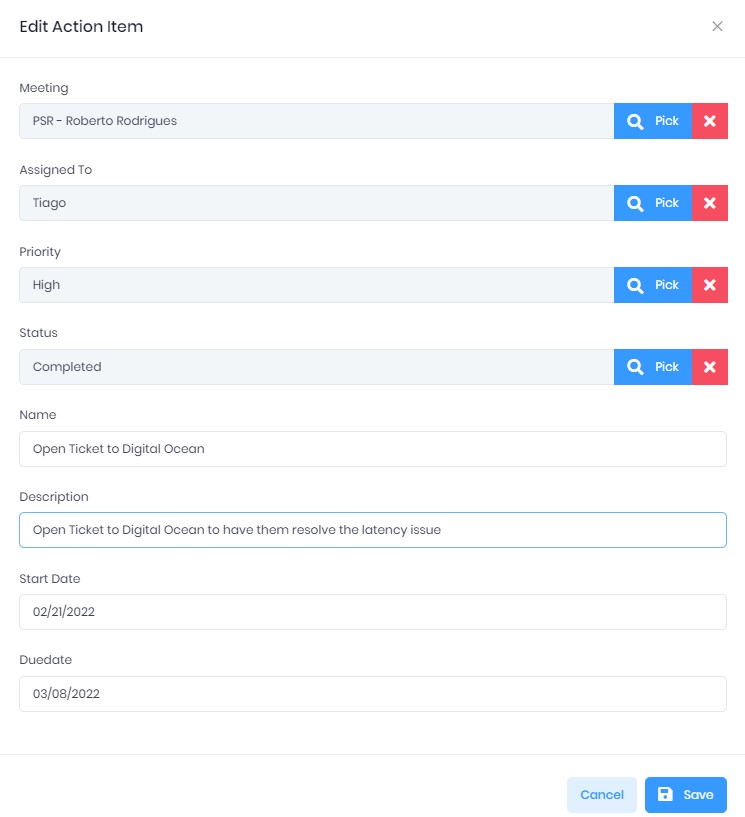Home - Meeting Agenda - How to Manage Meeting Action Items?
How to Manage Meeting Action Items?

Managing Meeting Action Items for Effective Meetings
Action items can make meetings more effective, but managers need to understand how to create and manage these tasks. Continue reading to learn more about managing meeting action items.
Table of Contents
Identifying action items and task and team to-do lists is essential; otherwise, the meeting will waste time and resources. In some cases, team members can volunteer to carry out the tasks. Other times, the activities are delegated to the most qualified teams and members.
The tasks are usually in the minutes of meeting, and managers can track them using sophisticated software designed for managing action items. Here’s an overview of what managing a meeting action item entails, including the uses, benefits, and how to leverage task management tools.
What Are Action Items?
An action item definition describes it as a task assigned to a team or individual during a meeting. The action item comes from the meeting notes and tasks discussed during the gathering. During a meeting, the team will identify goals and tasks needed to achieve them.
Individuals and teams are then assigned their role/responsibility and may be required to report once tasks are completed. Most forward-thinking companies use convenient management tools to assign, track and follow up on meeting duties.
As teams and tasks grow, managing the action items can become a challenge without a meeting productivity tool. Too many tasks to a large number of people becomes difficult if not impossible to manage effectively.
The best productivity tools offer customizable templates and sophisticated tracking and analytics programs required for efficient management. This facilitates the management of action items.
Why Use An Action Item?
Action items are essential for anyone looking to hold effective meetings. The success of a meeting depends on executable action items raised and the ability to follow up and ensure task completion within the set schedule.
Here are three reasons for using an action item:
1. Provide Clarity
After a meeting, all members should be clear on their responsibilities and what they should accomplish to achieve discussed goals. Each team member should understand their tasks and deadlines. An action item provides clarity on who should do what and when.
2. Better Accountability
Meeting action items create a sequence of task and deadlines, keeping projects on course. Organizers can record the duties in meetings and track progress to ensure everyone is doing their bit.
The action items can increase accountability among members when they see others accomplishing assigned tasks. When assigning an action item while using meetingforgoals.com you can easily see what action items were assigned to who and therefore it becomes much easier to track.

3. Tracking Progress
Once tasks are delegated, follow-up is necessary to track progress and keep deadlines. The team leaders can review past meetings to identify who’s responsible for specific activities. To review past meetings you need to have minutes of meeting therefore it becomes crucial to maintain these records.
Part of tracking progress also requires members to generate reports indicating their progress and task completion.
How Can Meeting Action Items Improve Meeting Effectiveness?
The main goal of setting action items is to improve meeting effectiveness. Each gathering needs a meeting agenda for members to discuss and come up with resolutions. An action item is a specific task delegated to a team or individual.
It features what needs to be done, who should do it, how it should be carried out, and expected deadlines. Once an action item is assigned, those responsible for acting on the task have a deadline to work with.
The tasks have measurable outcomes that managers can track to ensure their delivery is according to plan. Without action plans, the meeting is just another gathering with no value to the members or organization. Meeting action items ensures every member has a part to play.
Benefits of Action Items
The merits of using action items cannot be understated. Meetings should inspire action to move closer to the company goals or resolve existing issues.
Any meeting whether it is an in person meeting or a virtual meeting without well-thought tasks is a waste of time and resources. Meeting attendants need a straightforward course of action and understanding of their responsibilities.
Action items determine the task to be carried out, the assigned team, deadlines, and reporting requirements. The main benefits of using action items include meeting efficiency, task delegation, accountability, and progress tracking. They also simplify meetings, align with set agendas and make it easier to manage organizational processes.
What Are The Attributes Of Action Items?
An action item is a task that a member or team should carry out within a specified duration. Meeting organizations should think about the key aspects; what, who, when, and what next, when writing an action item. Here are the attributes of practical meeting action items:
a) They are Descriptive
The task is the main aspect of an action item because it describes what’s to be done. Action items should have a clear description of the item that needs completion. The goal is to give context and make it easier for members to understand what’s required.

b) They Have Purpose
Action items meaning isn’t complete without purpose. People create tasks to achieve something, so the action item should explain how it will push the team closer to identified goals. It should effectively discuss the purpose to motivate people and increase understanding of how the responsibility aligns with the bigger picture.
c) They Have Due Dates
Every action item should have a due date and a realistic schedule to ensure enough time for completion. Those who oversee task completion should remain firm on deadlines to set a precedent but need flexibility and priority. Managers should communicate any modification to the respective teams early to eliminate roadblocks.
d) They Delegate Responsibility
An action item identifies who is responsible for fulfilling the task. Responsibility delegation is vital because tasks should be given to the most suitable individuals or teams. Every action item should be assigned to a person or group for easy follow-up and tracking.
How to Write Better Action Items?
The easiest way to write an action item is using a template. A meeting agenda template or action item template makes the process effortless. Managers can also use meeting software like Meeting For Goals to leverage professional templates and remote experts.
Action items should be clear, descriptive, and definitive, leaving no loopholes. Assignees should also be up for the task and be provided with what they need to play their role.
Here are some action items examples, including strong and weak versions:
Action Item Example 1
- Weak Action Item: Sharon will handle the TPS reports.
- Strong Action Item: Sharon will file the TPS reports with Ken by Friday afternoon.
Action Item Example 2
- Weak Action Item: The team will present a proposal at the conference.
- Strong Action Item: Pauline will draft the proposal for the conference and share it with all team members before Friday for review in the next meeting.

Ownership of Action Items
An action item can be delegated to multiple groups and individuals, depending on the scale of the task. However, each item should have one owner responsible for its completion. One of the don’ts of writing a meeting action item is delegating one task to more owners.
It can reduce accountability and result in delays and communication breakdowns. The ownership is usually discussed during the meeting, after which one owner is assigned a single item action. The owner can be an individual or team member.
What to Do When Action Items Are Not Completed On Time?
Action items are time-sensitive and should be completed within the set due dates. Weekly reviews can determine if a task requires more work than anticipated, in which case managers can add the item to a work plan.
If an item isn’t completed on time, the responsible owner should provide a report detailing the delay to help management determine the next course of action. A one on one meeting may be necessary in such cases.
Proper tracking can prevent delays by identifying overload early and making changes to ensure everything remains on track. Sign up today for FREE to meetingforgoals to learn more about how you can run effective meetings and assign action items easily.
Meetings That Get Results, For High Performing Teams

Meeting For Goals Editorial Team
Meetingforgoals helps teams eliminate useless meetings that do not advance the company goals. Our software helps you align meetings to company goals, to have a meeting agenda, allocate action & responsibility and save time. Never have a bad meeting again 💪

How To Reduce Meetings in the Workplace
Introduction Every manager has been in a meeting that went on way too long, or spent too much time discussing things that could have been

Tips to improve your meeting culture & Symptoms of bad meeting culture
Introduction Meetings are an essential part of every company’s life, but they can also be a huge waste of time. The good news: with some

Why are meetings important? Their Advantages & Tools to Have Great Meetings
Introduction Meetings are an essential component of running a successful business. They help you share information, solve problems, and give everyone on your team an
